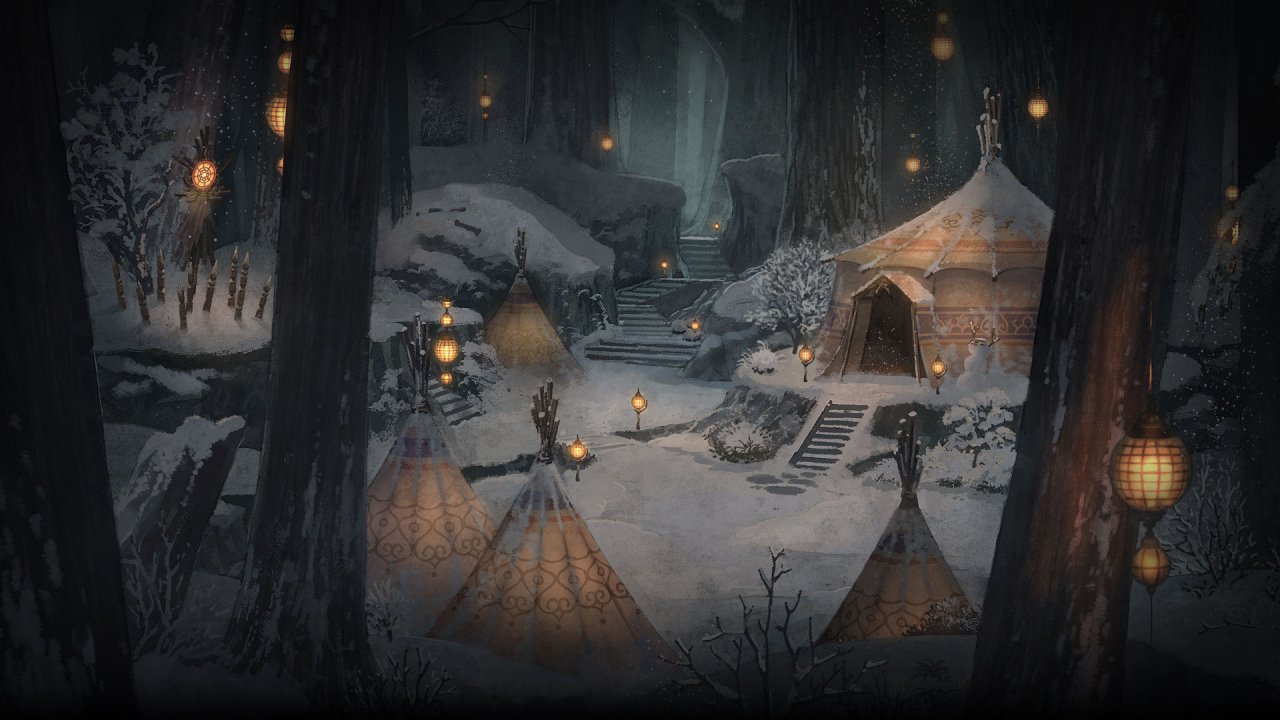“There is a small island just off the mainland. A girl there will be turning 18 this year…
…I want you to kill her.”
The words echo in Endir’s mind as he studies his unique, self-forged blade.
The ship would soon be arriving at the village of Nive. A mercenary should never question the job… but he couldn’t help feel an uneasiness settling around him.
Why did he take on this mysterious task? What was this anxiety he was feeling in such a relatively straightforward job? Who is this girl?
Thoughts aside, he presses on through the cold, snowy plains in search of his mark; completely unaware of the long journey ahead of him…
I am Setsuna has immense shoes to fill by claiming to be an homage to what many consider to be one of the greatest JRPGs of all time—the legendary time-traveling adventures of Crono and company in Chrono Trigger (SNES). Thankfully, I’m proud to say that the wait has been worth it. I am Setsuna, so far, mostly fills the giant hole left in our hearts after Chrono Cross (while still great on its own) failed to deliver the same experience that Chrono Trigger did. It isn’t by any means a sequel, and decades later, the story feels less unique; however, it is a solid entry into any JRPG lover’s library, and will help tide you over until we get the big behemoth JRPG titles coming up later this year.
What’s to love about I Am Setsuna? Almost everything. Almost.
The first striking note (pun intended) of I Am Setsuna is the musical score. I know, I usually leave music for last, but this one delivers an auditory experience that I have not had from a JRPG in ages. This title is scored and composed entirely focused on the piano as the primary (and many times, only) instrument. What better instrument to capture all of the emotions in a typical JRPG’s sweeping story? Haunting ominousness, joyful victory, alarming panic, tragic defeat, witty comedy… all of these emotions are not only amplified, but at times, wholly evoked by the sometimes tender, sometimes powerful, but always appropriate piano. I came into the title unaware of this, and it absolutely blew me away artistically. If I had to, I’d categorize it as heavily influenced by traditional Japanese cultural style, but tuned towards your expected JRPG archetypal elements (fanfares after battle, dire boss battles, charming and catchy normal battles, ambient dungeon music, and lively town music). It’s totally appropriate for the art direction, and I can’t seem to get my mind off of it.
The second most notable approach is the art style itself. Graphically, I am Setsuna is not your crazy AAA JRPG (concerning system requirements and GPU load), but artistically? Dead on. What’s the difference? Graphically, to me, intends to speak about technicalities (models, textures, anti-aliasing, etc.), but artistically intends to speak about conscious decisions by the game’s art directors to put the world and characters together. Thematic choices versus technical features or limitations. Lesson over, let’s get back to I am Setsuna.
Artistically, I am Setsuna fits like a damn glove, although it is not necessarily perfect.
The best way I can describe the art approach is one in which textures are almost designed as if by watercolor, but the models are done in a way akin to a true HD remake of Final Fantasy III (PC/NDS/PSP). Relatively small legs and arms, larger heads and bodies. Almost as if you took that Final Fantasy III and merged it with Chrono Trigger in terms of camera angle and art style. Anti-aliasing on the models is spot on, and weather effects are constantly on, really amping up the atmosphere of a cold, icy world filled with monsters. Now, we aren’t looking at the art of Akira Toriyama this go around, but it’s still done in a way that fits both I am Setsuna as its own title, as well as an homage to Chrono Trigger. It was pleasant on the eyes while filling the tropes we expect to see from a JRPG. Nothing seemed out of place whatsoever, and I truly felt immersed in the world I was exploring.
What fans were truly hoping for, however, had nothing to do with art, graphics, or music. It had everything to do with game mechanics. It has been two decades since we saw a battle system as fantastic and seamless as Chrono Trigger’s. The Active Time Battle (ATB) system has been done time and time again since; however, the Tech system had not been mastered like Chrono Trigger had done. In both titles, characters learn techniques (commands and magic), and once learned, if cross compatible with another character’s (or characters’) technique(s) currently in the party, they can combine them for a dual or triple technique. It doesn’t sound so revolutionary, until you realize how logically thought out the system is, and how well planned the characters’ crossover of abilities is done. For example, going back to Chrono Trigger, the fire user Lucca can throw her fire magic on Crono’s blade while he uses Cyclone (a spin attack), imbuing the spin attack with extra fire damage. Or, Marle, the water user, can cast Ice on Crono’s blade as he commits to a plunge attack, freezing the enemy, upon which shatters, adding ice damage. It’s almost anime-esque if you picture it going down in your mind.
I am Setsuna uses this exact system, but adds to it, while offering a direct homage to its predecessor via some cross techs taken straight from it, such as Cyclone and X-Strike. Characters do not naturally learn abilities but have set abilities they can learn by equipping spritnites to their person or accessories (called talismans). These spritnites are essentially stones that have the abilities within them, and allow the characters to use those abilities in combat. Dual and triple techs still exist, but must be discovered by mixing and matching which spritnites are equipped and which party members are taken into combat with you. Discovering new abilities and cross techs is tons of fun, especially since they are not innate to the character. Different characters can be built a few different ways, offering a little more flexibility in build than its predecessor did.
Further building on the winning mechanic formula, two other mechanics have been added to combat to keep things fresh, and keep the player on their toes (both strategically and in execution). Turn based combat in JRPGs admittedly has not aged well since the golden days of SNES and PSX goodness, so keeping it fresh by advancing the formula is critical in a quality JRPG in 2016. I am Setsuna does this through two systems—the Momentum system and the Fluctuation system.
The Momentum system rewards the player for taking their time to think about their actions in combat through additional effects on attacks and spells by filling a gauge called the SP gauge when the player sits with a full ATB meter but has not entered a command yet. When this gauge fills, an SP point is granted to that character, which can then be used to augment a command. This is done by pressing the appropriate button as the character is in the animation for the action the player selected, at the appropriate time in the animation. This timing based augment does help considerably in doing anything from adding damage to the attack, boosting the character’s ATB when they are healed, or even adding a status cleanse effect to a group heal. Very, very, VERY useful, effective, and well balanced. You might take an extra hit or two waiting for that SP to fill up, but that cleanse or boost may give you a tactical advantage coming up!
The Fluctuation system is a bit more random, but lends to both alter combat experiences from fight to fight as well as to help offer more customization to a character’s techs. Sometimes, random effects can trigger in combat which aids the party, called fluctuations. Sometimes, these could add to tech power for 20 seconds, or increase physical damage for 20 seconds, for example. I’m currently not sure what triggers them, and even the story says these are random, but a pop-up notifies you of the upgrade and length mid-combat, and you can then speed up your strategy to take advantage of it, or ignore it as you see tactically fit. These fluctuations also somehow play into the flux system, which allows you to add variations to your spirnites, altering the statistics or benefits that equipping that spirnite gives you, over an identical spirtnite of the same ability, but with a different flux or no flux at all. I’m not sure exactly what triggers the spritnites to learn fluxes besides equipping and using them, but I’m looking forward to delving deeper into this system to build the perfect fighting force of three.
Story-wise, I don’t want to spoil, but so far, so good!
It’s certainly not as jarring or twist-filled as its predecessor, but there’s a great depth to the world it is set in. The characters, while certainly feeling more stereotypical of an adventure anime series (stoic male lead, eternally positive female lead, the tomboyish best friend, the cute chibi kid, and the gruff bulky soldier, for example), did have depth and motivations to them that helped differentiate them. I love character depth and development, and so far, they all seem relatively dynamic, and I’m highly looking forward to discovering what else the world has in store for us on the sacrifice’s trip to the Last Lands. I’m expecting some big revelations and twists but haven’t encountered them quite yet. My only concern is that I have heard word that the main story is about a 20 to 30-hour affair, which is relatively short in the JRPG world. I hope that in that length of time, the efficacy of masterful storytelling has enough time to grow from the seedling to the majestic oak that I expect from anything claiming to be akin to Chrono Trigger.
And, finally, my only complaint is a lack of voice acting. Maybe it’s just me, but I feel like I can get more engrossed in a story these days when quality voice acting has been committed to a game, as they can help deepen both the dynamic aspects of each character, and also pinpoint their personalities in the way that the script writers intended. This disappointment was coupled with the fact that the beginning of the game specifically asks if I’d like to turn voice overs on, which I did, but was not granted any voice acting… until I figured out that the voice overs they intended were only small phrases said by the characters in combat to confirm commands, confirming that they were ready to take action, performing techs, or catchphrases stated when combat was over… and in Japanese only. While I’m a fan of Japanese voice acting, it would have been nice to see at least those done in English as well for its release.
The Verdict
All in all, I am Setsuna will be a treat for any JRPG lover in today’s market, and is absolutely worth picking up even at the $40 price point. I can’t wait to discover all that Setsuna herself has to offer, and figure out who she is, and how she can save the world from the impending monster invasion. Great mechanics, fantastic artwork, and music that creates atmosphere rivaling even the great John Williams are all wrapped up in one nice and neat package.


